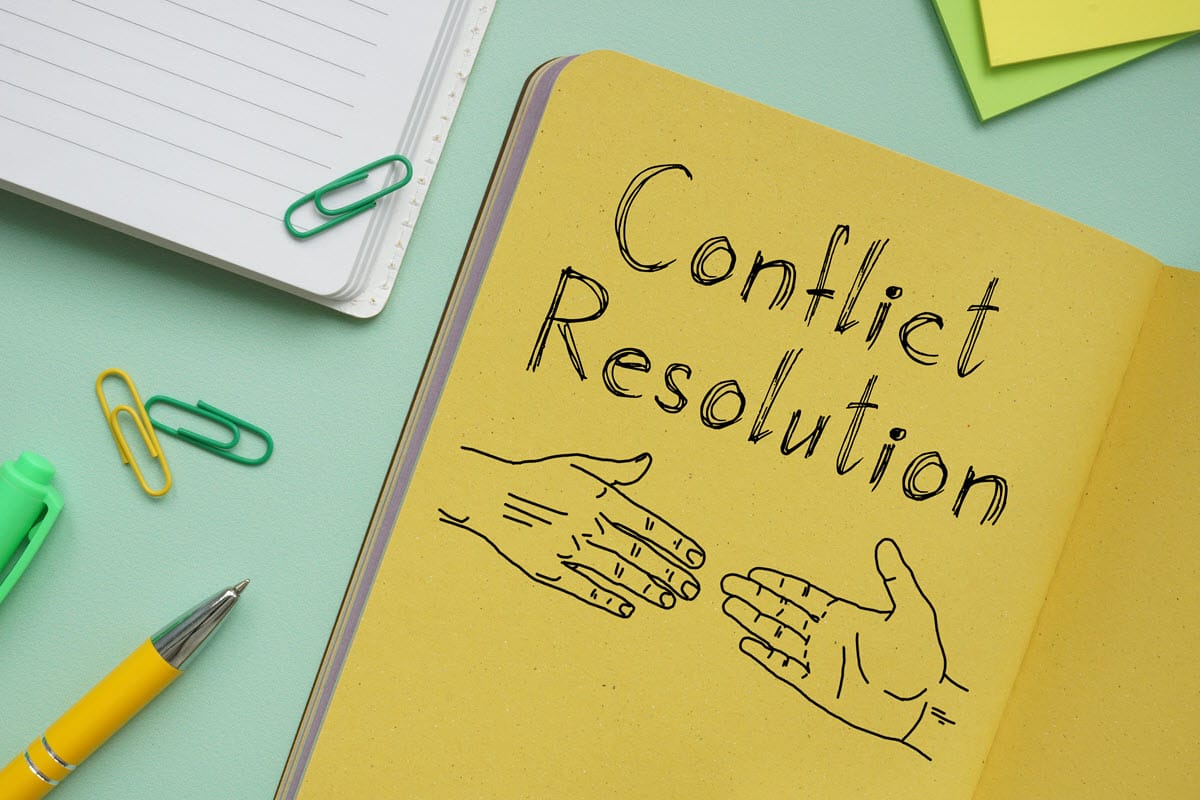Workplace conflicts are inevitable, but they don’t have to harm your organization. This article on HR conflict resolution will show you effective strategies to manage disputes, understand HR’s role, follow step-by-step resolution processes, and implement conflict prevention measures. You’ll learn how:
- HR plays a key role in conflict resolution by fostering a supportive environment for employees and ensuring neutrality during mediation.
- Effective conflict resolution strategies include promoting open communication, setting ground rules, and finding common ground among conflicting parties.
- Regular follow-ups and adjustments to resolution plans are essential for addressing ongoing issues and maintaining a harmonious workplace.
Understanding HR’s Role in Conflict Resolution

HR’s involvement in conflict resolution is crucial for preserving professional relationships and maintaining good internal communication. Workplace conflict, defined as disagreement or friction between individuals or groups, is considered inevitable due to various workplace stressors. When unresolved, these conflicts can lead to increased stress, decreased job satisfaction, and lower productivity. Conversely, effectively resolving conflict can lead to personal and professional growth, benefiting both individuals and the organization.
The role of HR in conflict resolution extends beyond simply addressing issues. It involves creating an environment where employees feel supported and empowered to resolve disputes constructively. This proactive approach helps avoid conflict escalation and fosters a culture of collaboration and mutual respect, highlighting the importance of conflict resolution skills HR.
Identifying When HR Should Step In
It’s important to know when you should get involved in a conflict as an HR professional. In most cases, HR should step in when there is a potential for conflict escalation that employees and their managers cannot manage independently. Common issues that may mature into conflicts include conflicting priorities, generational clashes, and differing assumptions. Understanding what differentiates a disagreement from a workplace conflict is vital, as the latter significantly impacts team dynamics and individual morale.
It’s essential for employees to feel comfortable asking for help when needed. HR must ensure that employees feel supported and view involving HR as a positive step towards resolving disputes. If an employee asks for help, it’s important that you step in to either help resolve the conflict or provide suggestions. Sometimes managers are the first line of conflict resolution; however, when managers struggle to mediate effectively, HR’s role becomes pivotal in supporting employees and finding solutions.
Acting as a Neutral Third Party
HR’s neutrality during conflict resolution helps ensure that the mediation process is perceived as fair and objective. An unbiased stance allows HR to guide discussions toward resolution while ensuring all parties feel heard and respected. This neutrality facilitates constructive discussions focused on finding a solution.
Remaining neutral also means avoiding favoritism and ensuring transparency in the process. This approach builds trust among employees and encourages open engagement in the conflict resolution process. It establishes that the solution will be fair for both parties. As a neutral third party, HR can facilitate discussions, help parties find common ground, and work towards mutually beneficial solutions.
Key Conflict Resolution Strategies for HR Professionals

Implementing effective workplace conflict resolution strategies is an essential skill for HR professionals. From a big picture perspective, these strategies aim to increase engagement and retention, eliminate distractions, and support a healthy culture at an organization. Fostering a culture of understanding and encouraging open communication and collaboration are necessary to achieve a healthy conflict resolution strategy.
Clarity and active listening in communication are fundamental in mediating workplace disputes. Poor communication can lead to misunderstandings and additional conflicts. Adopting best practices in mediation and maintaining empathy enables HR professionals to navigate conflicts effectively and ensure positive resolutions.
Setting Ground Rules for Discussions
Set ground rules to ensure clarity in discussions and protect workers against inappropriate behavior. Such rules create a safe space for participants to express their grievances openly. Setting ground rules will promote respect and allow the expression of feelings and opinions among participants. Examples include:
- Privacy – Private meetings with only HR and the involved parties are vital for encouraging open and honest dialogue. Everyone should also agree to keep conversations confidential.
- Transparency – All parties will be up front and honest in order to resolve conflict.
- Neutral Problem Solving – The HR team member will remain neutral and focus on resolving conflict in a fair and unbiased way.
By setting these ground rules before discussions, you’ll ensure a more positive interaction. Privacy and clear boundaries are essential for resolving conflict in the workplace effectively.
Encouraging Open Communication
An environment where employees feel secure to express their opinions is vital for addressing conflicts. Encouraging employees to discuss work issues fosters an open communication environment. HR can encourage openness in conflict situations by allowing free expression and maintaining confidentiality.
Ask questions and focus on employees’ perceptions to understand their concerns. Acknowledge hurt or anger to allow parties to express their feelings. Conduct regular follow-up sessions that allow participants to share subsequent experiences and progress toward a solution. Continue to foster open dialogue about the resolution’s effectiveness.
Finding Common Ground
Identifying shared interests between conflicting parties is essential for collaborative conflict resolution. Collaboration involves working together. The objective is to find a solution that meets everyone’s needs. Parties should be open to making sacrifices in a compromise. Such willingness is essential for reaching an agreement.
Finding common ground helps create solutions acceptable to all parties involved, leading to a mutually beneficial solution. This approach resolves the current conflict and builds a foundation for better understanding and cooperation in the future. Focusing on shared goals and interests allows HR to facilitate discussions leading to mutually beneficial solutions.
Ensuring Employees Feel Heard
Conflict resolution can only be successful if the employees’ issues are taken seriously, regardless of how petty the issues may seem. Employees need to know that HR listens and understands the challenge before they will accept any part of a resolution plan. This point cannot be understated. Ensuring employees feel heard is vital to HR’s role in conflict resolution and is a critical ground rule to acknowledge throughout every step of the process. It is key to any conflict resolution strategy.
Steps to Resolve Workplace Conflicts

Resolving workplace conflicts involves a step-by-step process the HR department should follow for effective conflict resolution. Agreement on the issue between conflicting parties is vital for a successful resolution.
HR departments can assess resolution effectiveness by tracking the resolution process and evaluating outcomes. Ongoing evaluations post-resolution verify that the implemented solutions were effective. They also identify if further adjustments are necessary. Follow-up meetings can uncover deeper issues not addressed during initial resolutions.
Acknowledge and Define the Problem
Ignoring conflicts typically worsens the situation. The first step is to acknowledge the problem and commit to finding solutions. Clarifying the conflict’s source is the main step in solving any workplace conflict. HR should identify the problem statement without emotions to address conflicts effectively.
After discussing views in a conflict resolution meeting, both parties should agree on what the real issue is. This mutual understanding sets the stage for productive problem-solving and ensures all parties are on the same page.
Gather Information from Involved Parties
Conducting a proper investigation to understand the situation is a key step in conflict resolution. Gathering initial information is crucial to understand all viewpoints and thoroughly investigate the case. HR should meet with individuals separately to gather information and then determine the best approach for mediation.
Obtain as much information as possible on each side’s outlook to fully grasp the situation. In some situations, HR might decide not to have conflicting parties meet. Separate meetings may be necessary to protect employees from personal attack or maintain confidentiality. In either situation, try to summarize and repeat statements during the information gathering stage to fully understand the situation.
Develop and Implement a Resolution Plan
Determine a goal and develop a plan to effectively resolve the conflict. The aim of a resolution meeting is to brainstorm solutions addressing the conflict and assess if the proposed solutions will be effective. It’s important to find a middle ground that is satisfactory to all involved parties. Employees should leave the final resolution meeting with a plan in place to implement the solutions agreed upon during previous resolution meetings.
Follow-up discussions help determine if the implemented solutions are genuinely effective and embraced by employees. The Follow-up meeting promotes accountability among involved parties by reviewing their commitments to the positive resolution.
Training Managers in Conflict Resolution Skills

Training in conflict resolution is important for managers and employees as it equips teams to handle conflicts effectively. Managers establish a safe workplace by setting expectations about behaviors and facilitating conflict resolution. Managers should encourage open dissent focused on tasks, strategies, and mission to promote healthy conflict. New hires in leadership roles should receive training that emphasizes organizational standards and culture.
Provide Conflict Resolution Training
It’s important to schedule training programs for managers that will benefit from conflict resolution strategies. Training might include workshops tailored to specific workplace challenges. Issues that the specific team is facing, like communication barriers or team dynamics, can be factored into their conflict resolution training program.
Not all managers learn the same way. Practical scenarios and role-playing exercises help some managers better understand and apply conflict resolution strategies. This hands-on approach can ensure managers are well-prepared to handle real-life workplace conflicts when they arise.
Conflict resolution training can be a daunting task for HR to take on. The time it takes to create and conduct training takes a large part away from their other responsibilities. An excellent solution is to outsource this type of training to professionals that work with conflict resolution daily. It not only relieves an already over-burdened HR team, but attendees will take the training much more seriously.
Regardless of the type of conflict resolution training that HR provides, it is essential for managers to know how to effectively address and mediate team conflicts.
Establish Relationships Before Conflicts Occur
It is very important for HR to carve out time to establish relationships with managers, supervisors, and other employees prior to resolving conflicts that arise. With familiarity and respect for the parties involved, the conflict resolution process will go much smoother.
An ideal time to establish a relationship with managers and supervisors is during conflict resolution training, especially if training is outsourced to a third party and HR personnel attend as another “student”. Networking during training breaks, asking good questions during the training, and following up with supervisors are all opportunities to solidify this relationship. In addition, managers know that HR received the same training they did, so everyone understands that the conflict resolution processes are consistent.
If third party training is not possible, the HR team should explore other ways to establish a solid relationship with managers and supervisors. Depending on the company, team building events can be beneficial to assist in fostering a strong team relationship and can be a proactive way to avoid conflicts or resolve them.
Ensuring non-managerial employees are familiar with HR personnel is also extremely helpful when conflicts arise. When there are hundreds or even thousands of employees, this can be challenging. But there are numerous ways to establish familiarity, if not a relationship.
- Assign an HR team member to personally make HR-related announcements at all-employee meetings. This is especially helpful for positive announcements such as new employee benefits, third-party training, and more.
- Ensure all-employee emails from HR contain an HR team member’s signature, and if possible, their picture.
- Add HR announcements and team member names and pictures to the employee newsletter.
- Include “open-door” messages in communications to make a positive impression.
- Continually promote the company’s EAP (Employee Assistance Programs) in HR announcements. This can also be tied into the conflict resolution process itself by ensuring every employee involved in the process is given an EAP card that outlines this confidential resource.
There are numerous, relatively simple ways to enhance relationships between the HR team and other employees. They shape employee attitudes about HR so they enter a conflict resolution with positive thoughts that things really can change for the better.
Promote Continuous Learning and Improvement
Continued education in conflict management helps managers stay updated with the latest techniques, approaches, and communication styles for the organization. Refresher courses help ensure managers remain adept at navigating diverse workplace conflicts. Updated conflict resolution training should address specific challenges managers encounter in their roles.
Promoting continuous learning and improvement helps organizations foster a positive work culture and enhance employee relations.
Preventing Future Conflicts

The best way to resolve conflicts is to prevent them from happening in the first place. While it’s impossible to avoid conflicts entirely, there are many ways HR can prevent conflicts, or reduce their impact:
- Address and resolve potential sources of conflict, such as role ambiguity, communication breakdown, and interpersonal issues, to minimize future disputes.
- Intervene in conflicts in a timely manner, to reduce their impact.
- Collect post-resolution feedback from employees to highlight necessary adjustments to conflict management strategies.
- Document lessons from conflicts to build collective knowledge and advise changes to company policies and procedures.
- Equip managers with conflict resolution skills to prevent minor issues from escalating.
It’s also important to build conflict deterrence into the workplace at a foundational level. This can be done by establishing a positive work culture that encourages emotional wellbeing, respect, collaboration, and communication.
Building a Positive Work Culture
HR can drive the creation of an ideal workplace culture and support managers and employees in fostering a positive environment. Prioritizing the emotional wellbeing and mental health of employees is one paramount aspect of work culture that has deep impacts on the prevention of conflicts.
Promoting a culture of respect also helps organizations prevent conflicts and maintain high levels of employee engagement. Respect doesn’t just go from the bottom up—leaders and managers need to show respect and understanding toward all employees. This results in a positive atmosphere that promotes positive interactions at every level.
Encouraging Team Collaboration
Collaborative spaces encourage teamwork, leading to a more engaged workforce. Fostering teamwork is essential in preventing workplace misunderstandings and conflicts. Employees who feel part of a team are more likely to engage positively and work towards common goals, reducing disputes.
Effective teamwork enhances communication and trust, critical elements for conflict prevention. Encouraging team collaboration helps organizations create a supportive and cohesive work environment.
Monitoring and Follow-Up

After the individual interviews, the resolution meetings, and the implementation of a plan is complete, HR’s role is not done. It is critical to monitor the progress of the resolution plan to ensure it addresses the root cause effectively.
Persistent workplace conflicts require HR to spend significant time mediating issues to resolve conflict, often between one to five hours weekly. Success in resolving the conflict can reduce the time HR spends on future issues. The primary way to ensure that the HR intervention was successful is through follow up.
Schedule Follow-Up Meetings
Follow-up meetings assess the effectiveness of the resolution and discuss its progress. The meeting should be scheduled about two weeks after the initial resolution meeting to ensure effective implementation of the solution. Multiple meetings may be necessary for everyone to express their views, delve deeper into issues, or seek leadership approval.
In follow-up meetings, participants should discuss actions taken to ease tensions and to describe what is working well. This continuous dialogue helps maintain accountability and ensures that any adjustments needed to the resolution plan can be made promptly, fostering a culture of continuous improvement.
Adjust Strategies as Needed
Being flexible in conflict resolution plans allows HR to respond appropriately to new developments or unresolved issues as they arise. This adaptability is especially important since workplace dynamics are constantly evolving, and what worked initially may need to be adjusted to remain effective. If a conflict resurfaces after an initial resolution attempt, it is important to take necessary action and consider preventative strategies to avoid recurrence.
By maintaining an open line of communication and being willing to adjust strategies as needed, HR can ensure that conflicts are effectively managed and that the workplace remains harmonious. This proactive approach helps to address the conflict before it escalates, thereby promoting a positive work environment.
Summary
In summary, effective conflict resolution is essential for maintaining a harmonious and productive workplace. HR plays a critical role in this process by stepping in when necessary, acting as a neutral mediator, and implementing key workplace conflict resolution strategies. By setting ground rules, encouraging open communication, and finding common ground, HR professionals can resolve conflicts constructively.
Training managers in conflict resolution skills and promoting continuous learning is a vital piece of the puzzle in fostering a collaborative workplace. Preventing future conflicts through building a positive work culture and encouraging team collaboration ensures long-term harmony. Finally, monitoring and follow-up are crucial to ensure that resolutions are effective so adjustments can be made as needed. Embracing these strategies will transform conflicts into opportunities for growth and improvement, creating a supportive and engaging work environment.


